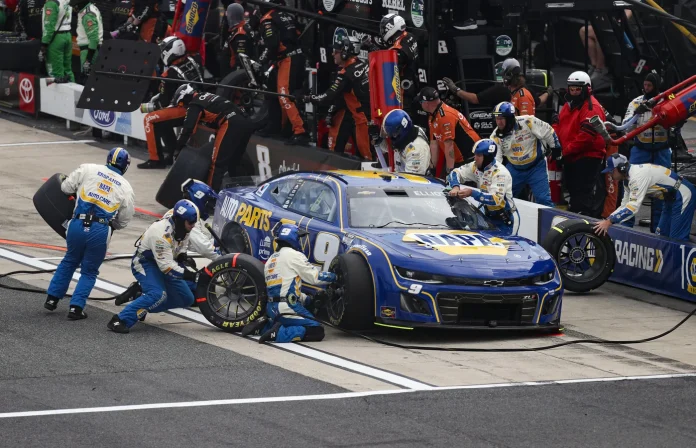The Chase Elliott Dover pit strategy debate intensified after Elliott discussed crew chief Alan Gustafson’s decision to take two tires during a late caution at Dover Motor Speedway last Sunday. With only six cars on the lead lap and just seven laps since his last stop, Elliott followed Gustafson’s call under the Lap 340 caution for rain, which later became the focus of widespread discussion.
Denny Hamlin and his No. 11 team chose to remain on older tires while most came in for fresh ones, a move that ultimately allowed Hamlin to capture victory. Despite Elliott leading a dominant 238 laps from the pole position, the decision led to a sixth-place finish, sparking debates over whether the pit call cost Elliott the win.
Looking Back: Elliott Weighs Pit Call Outcomes
After reviewing the sequence of events, Elliott openly acknowledged the consequences of Gustafson’s decision. He noted that in retrospect, mistakes become much clearer, and the team‘s decision-making comes under scrutiny. According to Elliott, the criticism would have existed regardless of the chosen route, since the opposing pit strategy would still have drawn complaints had it failed to produce a win.
“Easy to look back on that and realize you made a mistake,”
—Chase Elliott, Driver.
Elliott described the scenario as a no-win situation, pointing out that fans and analysts
“have all the answers to the test after it’s over.”
He explained that had the roles been reversed, with Hamlin pitting and Elliott staying out, public opinion would likely be just as divided.
Elliott also questioned whether Hamlin’s team would have stayed out if Elliott had made the opposite call, reasoning that starting with new tires at the front could have led to a different race outcome. Still, Elliott emphasized the challenge of making these decisions in real time, underscoring the complexity of race strategy at tracks like Dover.
“Denny did a really good job holding off the tires behind [him]. Does he stay out if we stay out as well, knowing that [new] tires was going to line up right behind us on the second row and he didn’t have control of the restart? I don’t think they do. But maybe they do. Regardless, it is a tough spot to be in, and it went the way it went. We can’t change it, but we can certainly take some lessons from the day and from the weekend and try to apply that forward to put ourselves in positions like that more often.”
—Chase Elliott, Driver.
Gustafson Expresses Regret as Elliott Claims Points Lead
Within the team, the decision-making process was marked by hesitation before Gustafson ultimately called Elliott in for a tire change. Gustafson later acknowledged regrets about opting to pit, according to comments made to The Athletic. Despite disappointment over the result, the performance at Dover represented a positive progression for the No. 9 Hendrick Motorsports team.
Elliott’s run at Dover Motor Speedway allowed him to overtake teammate William Byron in the regular season points rankings, further adding significance to the team‘s performance despite the late-race letdown. Consistent dominance at the front—a rarity for Elliott in the Next Gen era—suggested new momentum that the team hopes to maintain heading into the next event at Indianapolis Motor Speedway.
Implications for Upcoming Races
The Chase Elliott Dover pit strategy debate has shown how quickly fortunes can change due to split-second strategic choices. While the sixth-place finish was a frustrating outcome after leading most of the race, both Elliott and Gustafson indicated a commitment to adapting strategies and learning from this experience. All eyes will be on Elliott and the Hendrick Motorsports crew to see how lessons from Dover influence their performance at Indianapolis and future races as the season progresses.


